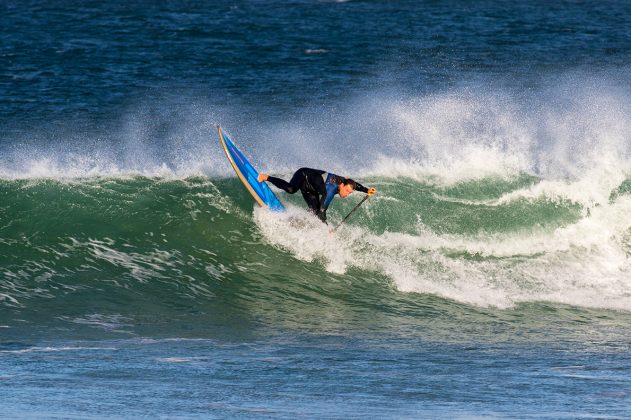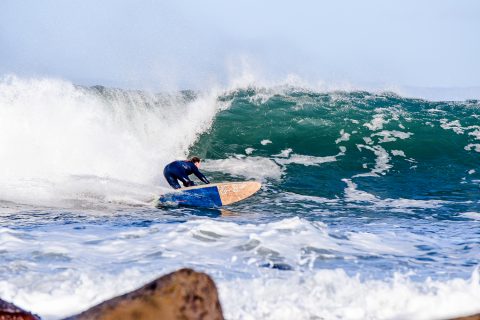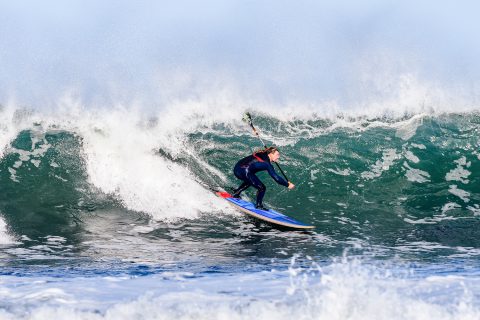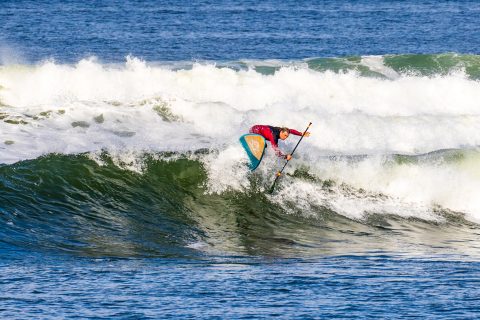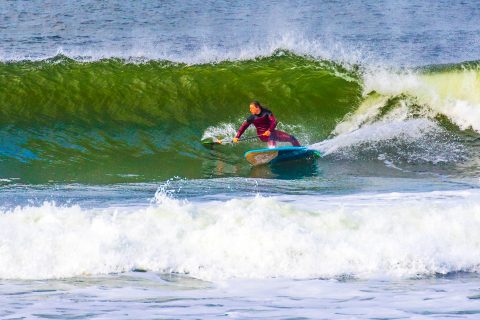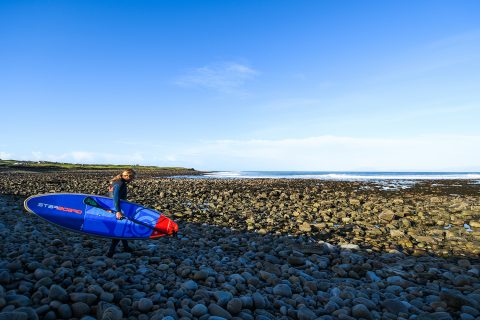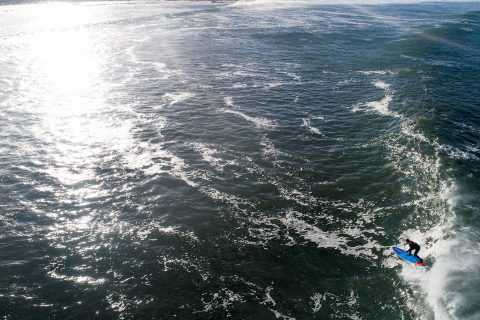HOME SCHOOLING
WORDS // Finn Mullen
PHOTOS// Ian Mitchinson and Katie McAnena
- Click to enlarge: Finn Mullen in the pit
What can we do to improve our sup surfing when we’re stuck at home and can’t paddle? It’s a question that quite a few of us have been asking lately for obvious reasons. Finn Mullen explores the options.
DRY STATE
The birds, lots of them, were singing, the sun was just warming up its blaze and clouds were in short supply. It was a perfect morning, except for the pandemic part. ‘I just need to get in the water,” I overheard the cashier tell her friend as I walked into the shop. I could relate, we could all relate, but lockdown meant there’d be no brine dripping from her or my nose today. It was back to the dry bubble of home. We’ve all been spending a lot of time at home recently, yearning to get wet, but it got me thinking, isn’t this just an exaggerated state of our normal? Like most of us, usually I spend more time thinking about sup surfing then actually doing it, and definitely more time at home than I do at the beach. Considering that’s the case, how can ‘off water’ time at home be used more productively to improve sup surfing skills? Lockdown was going to be the time to find out.
- Finn looking for the green room!
ROUGH WATERS
There was an irony to the fact that I’d started 2020 with a resolution of ‘Wet January’, where I resolved to spend every day of a normally bleak winter month on the water, paddling in both some horrendous and perfect conditions. That consistency and variety of practice yielded great results in quite a short time, but I knew that the daily hours it required to do it wasn’t feasible long term. Little did I know that just a few weeks later I’d be doing the complete opposite of my experiment and spending weeks off the water! But I consoled myself with every good scientific experiment needs a control to test its validity!
I’m not a gym person, if it’s there I’ll use it sure, like when staying in hotels and there’s no other exercise options, but generally I prefer my exercise wet and salty. And while lockdown spawned a rise in online fitness classes, I still wasn’t sure if I could connect the dots between them and my real goal of maintaining, or even better, improving my sup surfing level. Neither could I relate to the social media friendly clips of top action sports athletes juggling bananas while pulling backflips on a medicine ball balanced on a slack line. That level of ability, whilst super impressive, and no doubt beneficial in chasing that extra 2-3% in performance and getting legions of viral shares and likes, does take the hours that mostly only professional athletes have the time to train in. With little free time, I didn’t need circus tricks; I needed something more functional and something that could be achieved simply at home.
- Schools out!
WEAK POINTS
Like a lot of people, I do a variety of surf sports and one thing that I keep coming back to with SUP surfing is just how physical it is compared to a lot of other disciplines. Windsurfing, kitesurfing and wing surfing, all have a power source to do the heavy lifting, that’s obvious, but even surfing is a lot less effort, given that there is plenty of downtime sitting on the board between sets, rather than actively balancing like on a sup. And when paddling for a wave, surfing prone allows you to use your body weight spread out on your mid and upper area to put the board into its planing gear, whereas sup surfing your trying to exert that downward pressure for forward release through your two feet only. There’s a clue in there as to where the bulk of the work is directed in SUP surfing – your legs and feet.
LEG WORK
Even very good surfers can falter when they step on a SUP for the first time, as they aren’t used to spending so much time on a board standing up. More accustomed are windsurfers and kitesurfers, and generally they fare better, but no matter your background, almost all beginners have experienced the unsettling fatigue that is ‘SUP feet’! All those little receptors and muscles in your feet are suddenly working overtime to grip onto a shifting board on a shifting surface – it’s hard work for virgin soles! Technique adjustments, experience and muscle gains eventually lessen the load, but one of the best exercises I have found off a SUP for maintaining those balance muscles is standing on one leg with your eyes closed. There are volumes of information online on the benefits of this for your general health; some of it may even be true! And while there is lots of training devices out there like stability cushions and balance boards that help add variety to your balance training, standing on one leg gets the job done perfectly, as long as there is no peeking!
Anyone who has paddled in chop or current knows legs soon tire and cycling, especially of the hilly variety, I find one of the best exercises to keep calves and those important glutes in form. But if you can’t get hold of a bike, which like SUP’s seem to be the new ‘toilet paper’ in terms of pandemic demand exceeding supply, then if I was to narrow down one other exercise that I find of most benefit, it would be squats, simply because that is the closest relevance to the compression and release that we should aim for in a good bottom turn. If all that sounds like hard work and you want something more recumbent and less impact or want to upgrade your leg workouts, look out for used Pilates reformer machines that people have bought in TV shopping sprees, but then look to sell on cheaply after discovering they don’t work by remote control!
- Finn Driving hard.
WELL ARMED
You’d be forgiven for thinking these days if your biceps aren’t giving Popeye a run for his money then you’re going to be at the back of the queue for winning at life. So not true. Far from looking like walking billboards for using steroids or rather the reasons for not using steroids, the world’s best SUP surfers are lean, mean wave riding machines. As far as upper body brawn goes, SUP surfing requires short, intense and precise bursts of power to get on a wave and of course enough strength to get out and around the break. The latter is all about endurance and not as crucial as the former, which will dictate primarily if our mission to ride waves was successful or not! Neither require brute strength. Watching SUP racers SUP surf is a lesson in paddling with their well-honed cadence. SUP surfers aren’t always such pretty paddlers as shorter boards don’t lend themselves well to developing good technique, even though it is just as essential. A great tool to practice rhythm and technique is using a resistance brand looped round your paddle at top and bottom and the other end to a fixed point like a clothes line post or end of a rope anchored to something, then getting into your stance and using the simulated resistance to perfect your stroke. I’ve done this with everything from a broom handle to an upcycled broken paddle I found abandoned by a bin at the beach, right up to an all singing and dancing carbon paddle.
For added effect, get your board up on a beanbag or sofa cushions and practice paddling in your surf stance if you haven’t already mastered the art. While you are up there, practice transferring weight between your front and back foot in the fore and aft plane. For late drops you want to be able to weight your back foot to avoid digging the nose in, and for those waves where you just need to get a bit more oomph to get down the face you want to weight the front foot more; they are both essential skills and surprisingly easy to practice ashore.
Think too about how you would move your paddle during turns, but only how you should be moving it, not practicing bad habits! The best SUP surfers throw their paddle across their chest to effect turns rail to rail adhering to the good performance surfing practice of pointing the front / leading arm to where you want to go at the same time as looking in that direction, not the ‘poke and jam’ approach to digging a paddle into the face. So many correct paddle positions for transitions can be practiced on land so they become second nature on water. And if you want to take it further and really get a feel for turns on land, there is another tool – skateboards. During lockdown sales of these rocketed to unprecedented levels as dry docked surfers around the world sought to get their carve on. Specifically demand was for the new generation of ‘surf skate’ boards that have specially designed trucks that really mimic the dynamic state of carving on a face and pumping between sections. Surf coaches and pros alike love them, and if you haven’t tried one of the latest designs you will be surprised how realistic they are. Just remember concrete is a lot less forgiving than H20, particularly if the number of candles on your birthday cake could be considered a fire hazard! Specialist ‘land paddles’ feel great to use on skateboards, but you can still get plenty of benefit from using a basic wooden pole or cheap paddle that won’t mind a few grinds as you ride the hard stuff.
- Finn in the right state of mind.
MENTAL STATE
One of the most salient observations I witnessed over the last few months came from a young girl. When asked what she thought about missing so much school due to Covid-19, she quickly replied, that it had prompted her to consider studying psychology, as she found it incredible that of all the parts of our bodies, our minds seemed to play the strongest part in dictating our response to the pandemic. If we wanted to stay calm and not panic or be overwhelmed, it was our mind that controlled it that she argued. Experts may argue its flaws, but I liked her simple logic.
SUP surfing is a skill based sport, of course it’s physical, but at it’s heart it’s about acquiring and perfecting a set of skills, and in sport, that doesn’t always come about in the most obvious of ways. Like a lot of parents, one of the upsides of lockdown meant being able to spend a lot more time with our kids and teaching my 4-year-old daughter how to ride her bike gave some valuable insight. She ditched the stabilisers not through my coaching or guiding hand, but by, as she put it, ‘I decided I was going to ride my bike so I did’. The mind truly is a powerful tool, and a child knows how to use it in its most efficient state – with single purpose. Adult minds can tend to be a little more cluttered, but some of the most adept sportspeople at cutting through the fuzz are golfers. “Golf is 90 percent mental and the other 10 percent is mental too,” as the famous golf coach Jim Flick said. Now the closest I have come to playing golf is watching ‘Caddyshack’, and if I were to ever swing a club, my spirit animal would be Happy Gilmore. But it’s no secret that some of the world’s best surfers are also fanatical golf players, and the two sports share similar competitive psychology mantras – surf one heat at a time, one wave at a time, play one hole at a time, one shot at a time. Renowned sports psychologist, Dr Bob Rotella, was a busy man during lockdown advising some of the world’s top golf players. He shared some of that wisdom during a recent interview, “Work on your mental game and your physical side. Do some weights, but do a lot of mental preparation, a lot of visualisation, imagining yourself playing in a game, and imagine playing great…. I want a very clear, committed mind. Effectively, wipe your mind of everything but where you want the ball to go. A lot of golf is just getting into the present moment and having nothing in your mind, but where you want the ball to go. If you get good at that and love it, you’re going to play pretty darn good golf.” Surfing a wave naturally engenders clarity of purpose, but those points before, be it paddling for the wave, sitting in the lineup or getting ready to go out are where visualization and mental preparation can play their part. Big wave surfers can often be heard talking about, “I got the wave I wanted”. They will spend time surveying a lineup and visualizing the wave and type of ride they want to achieve for the session. Elite surfers will use downtime to picture in their head, step by step, a move they wish to perfect. But how can all these tools project into a more down-to-earth setting? It’s too easy to dismiss these things as not applicable to everyday surfing but they aren’t, this is an area where high performance tools can easily crossover. Spending time visualizing riding a wave, linking turns and performing aspirational moves is not wasted time. Watching videos on loop or studying pictures in detail in magazines shouldn’t be seen as idling, picturing yourself successfully nailing a drop or recalling past great rides isn’t big-headed, if seen in the right context to build your confidence. All we do to cultivate a positive mindset for our session prior to paddling out doesn’t have to be some weird hippy trip, it’s recognizing the value of simple processes that achieve larger successes. Almost all back-stories of top tier extreme sport athletes have anecdotal use of these tools. Just a word of warning though, like all tools these must be used safely and correctly, watching SUP surfing videos on loop ad nauseam for example in the company of friends and family may result in name calling and bits of food lobbed in your general direction!
- Birds eye view, Finn Mullen in acation.
FINAL LESSONS
It can be easy to become discouraged not spending time in the water while seeking to progress, but time off the water for whatever reason can be useful if channelled in the right way. The amount of time we spend actually riding in a session is very short relatively and leaves only a very small window to improve. So any work we can do outside of that to sharpen up our reflexes, instincts and movements to make those seconds count is vital. Moreover we can only really correct technique in those precious few seconds of the ride if we have a clear focus on what we need to do and how we are going to do it, and some of the best groundwork for that can be easily achieved with physical and mental rehearsal off the water and in the comforts of your home – no plane ticket or burnt hydrocarbons required!

